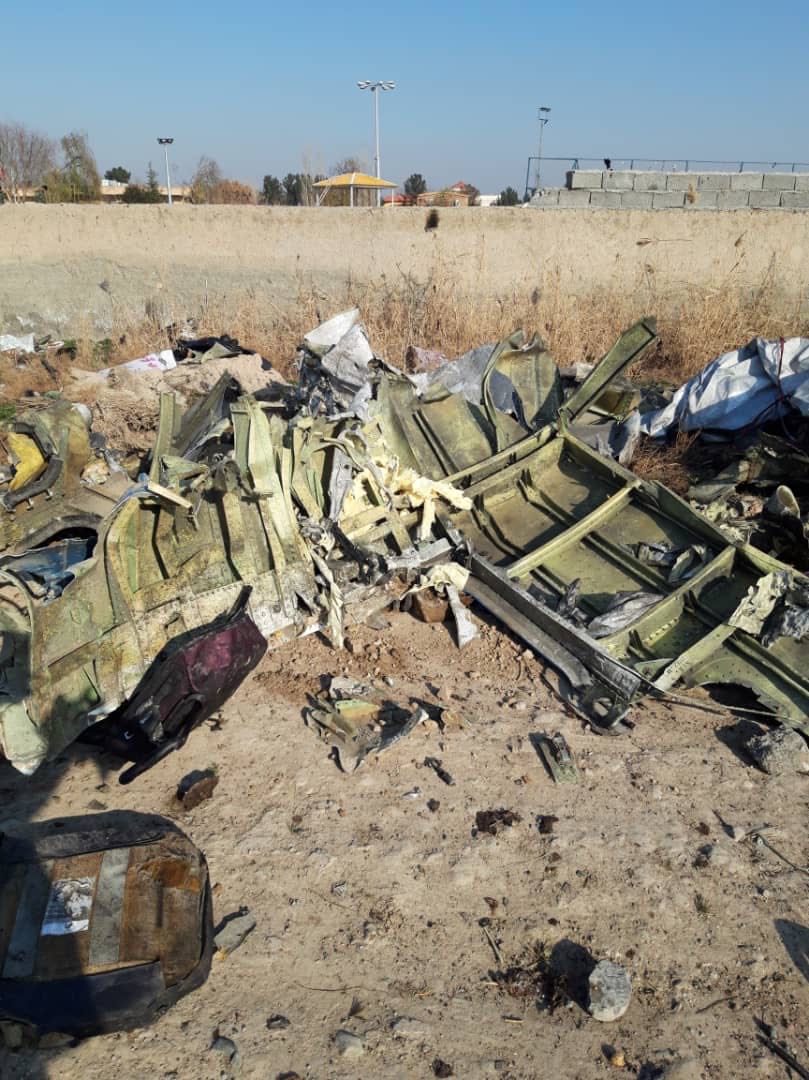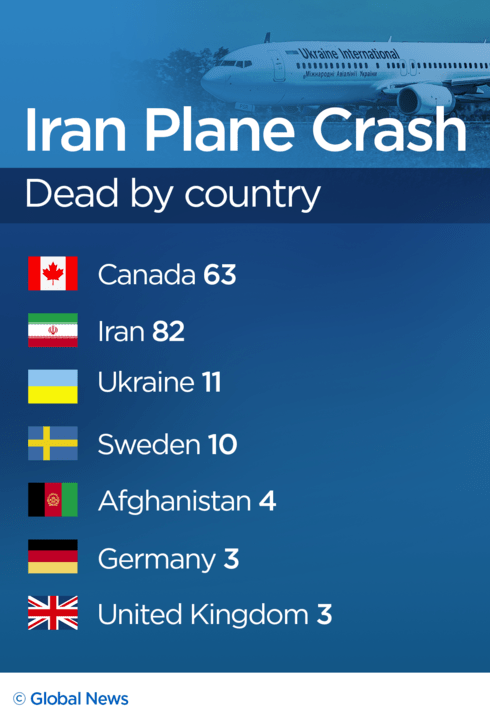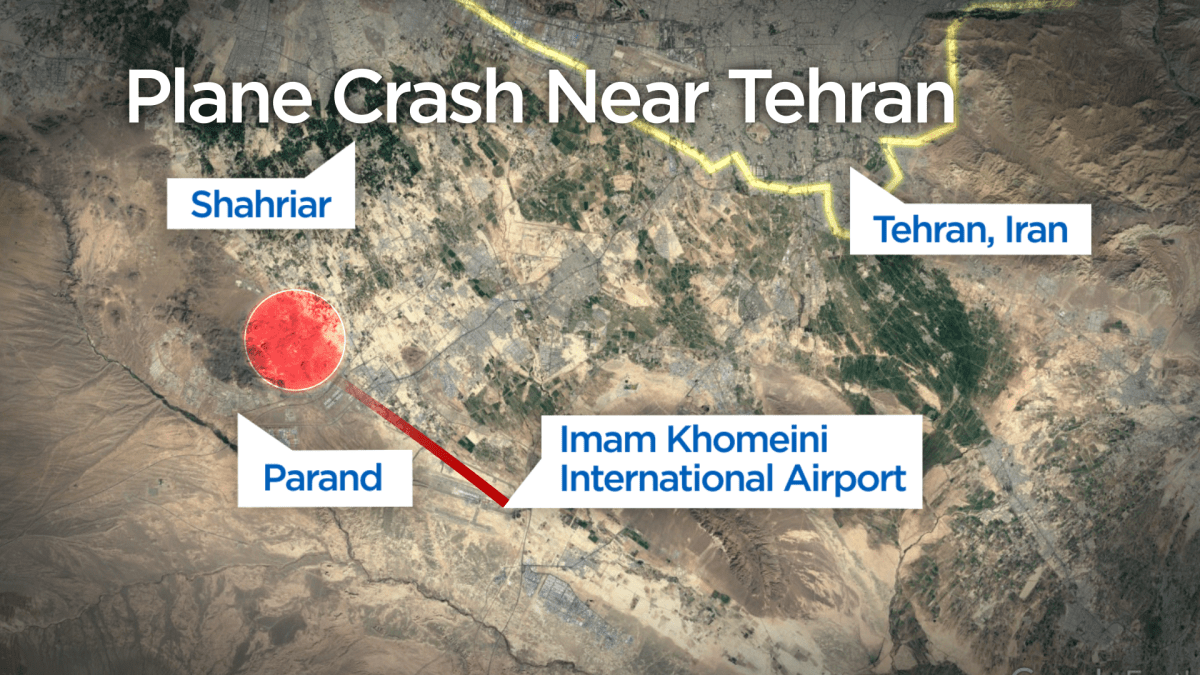EDITOR’S NOTE: Community leaders initially believed that 27 people with Edmonton connections died in the plane crash. However, they and Global News have confirmed 13. We have updated this story to reflect the new information.

Prime Minister Justin Trudeau says that most of those aboard Ukraine International Airlines Flight 752, which crashed near the Iranian capital of Tehran early Wednesday, were headed for Canada.
“On behalf of all Canadians I want to express my deepest condolences to those who are mourning the loss of a loved one. Your loss is indescribable and this is a heartbreaking tragedy,” he said at a press conference in Ottawa.
Of the 176 passengers on board the Kyiv-bound flight, 138 were supposed to catch connecting flights to Canada, Trudeau said.
Overall, at least 63 of the passengers were Canadian citizens, Trudeau said.
In addition to the Canadians, 82 Iranians and 11 Ukrainians were on the flight — the Ukrainian nationals included two passengers and the nine crew, according to Ukraine’s minister of foreign affairs, Vadym Prystaiko. There were also 10 Swedish, four Afghan, three German and three British nationals.
All on board were killed.
The crash happened early Wednesday morning hours after Iran launched a ballistic missile attack on two Iraqi bases housing U.S. soldiers.
However, Ukrainian and Iranian officials have both said a mechanical issue likely caused the Boeing 737-800 to crash.
Transport Minister Marc Garneau told reporters that the aircraft took off and gained altitude for two minutes before crashing.
“However, we lost contact with it, suggesting that something very unusual happened, but we cannot speculate at this point. There are a number of possibilities,” he said.

Garneau said the government is in contact with its international counterparts and that Canada is “offering technical assistance to the upcoming investigation.”
The Transportation Safety Board said that while Iran will lead the probe, the agency has appointed an expert to receive and review information released, and monitor the investigation’s progress.
Despite not having an embassy in Iran or formal diplomatic ties, Trudeau said Canada expects “to have a role in this investigation.”
“Canadians will be asking for answers and we’re there to support and find out the truth,” he said.
Canada’s foreign minister was expected to speak with his counterpart, Trudeau said, and Canada will be engaging with Iran indirectly through allies such as Italy.
On Wednesday, several commercial airlines were rerouting flights across the Middle East to avoid potential danger.
Air Canada rerouted its flight from Toronto to Dubai through Egypt and Saudi Arabia to avoid travelling over Iraq.
On Wednesday, Travel Canada issued a travel advisory urging Canadians to avoid all non-essential travel in Iran due to the “volatile security situation, the regional threat of terrorism and the risk of arbitrary detention.”

The advisory said Canadians, particularly dual Canadian-Iranian citizens, are at risk of being arbitrarily questioned, arrested and detained.
“Iran does not recognize dual nationality and Canada will not be granted consular access to dual Canadian-Iranian citizens,” the advisory reads. “Canadian-Iranian dual citizens should carefully consider the risks of travelling to Iran.”
The crash prompted an outpouring of grief across Canada.

Get daily National news
The victims, who lived throughout the country, included families, students and those working in academia.
Leaders in Edmonton’s Iranian community said at least 13 of the victims had lived in the city.
“I cannot believe we have lost that many people… I think every Iranian in the community has the same feeling,” said Shayesteh Majdnia, who said she was the best friend of Dr. Shekoufeh Choopannejad.
Choopannejad was an obstetrician and gynecologist. Born in 1963, she was in her late 50s and was on the plane with her two daughters, Saba and Sara Saadat. Both daughters were born Esfahan, Iran, but lived in Edmonton.
Ukraine International Airlines said it had indefinitely suspended flights to Tehran after the crash.
Ukraine President Volodymyr Zelenskiy said all of the country’s airplanes would be inspected, “no matter the conclusions about the crash in Iran.”
At a briefing after the crash, Ukraine International Airlines president Yevhen Dykhne said the aircraft was one of the “best planes we had, with an amazing, reliable crew.”
Airline officials said there was no sign that anything was wrong before the plane took off from Tehran’s Imam Khomeini airport and that it had last been routinely serviced on Jan. 6.
The plane was manufactured in 2016 and was acquired directly from Boeing, officials said.
UIA says on its website it had been awarded the IOSA — the IATA Operational Safety Audit certificate — meaning its operational and safety standards were fully in line with international requirements.
The airline, which operates domestic and international flights, has a fleet of 42 aircraft, according to its own website, made up of various Boeings, including 737-800s and 737-900s. It also operates Embraer aircraft.
The plane had been delayed from taking off from Imam Khomeini International Airport by almost an hour. It took off to the west but never made it above 2,400 metres in the air, data from the flight-tracking website FlightRadar24 indicates.
It remains unclear what happened. Qassem Biniaz, a spokesman for Iran’s Road and Transportation Ministry, said it appeared a fire struck one of its engines. The pilot of the aircraft then lost control of the plane, sending it crashing into the ground, Biniaz said, according to the state-run IRNA news agency.
On Wednesday, Ali Abedzadeh, head of Tehran’s civil aviation organization, said Iran would not give the black box of the crashed aircraft to Boeing.
Abedzadeh reportedly told semi-official Mehr news agency that at this time, it is not clear which country Iran will send the black box to for data analysis.
Hassan Razaeifar, head of the air crash investigation committee, said it appeared the pilot couldn’t communicate with air traffic controllers in Tehran in the last moments of the flight. He did not elaborate.
In a tweet Wednesday morning, Ukraine’s Prystaiko said he had spoken to his Iranian counterpart, Mohammad Javad Zarif, following the crash and that they had “agreed to coordinate further actions of our investigation groups closely to determine the cause of the terrible plane crash.”
The Boeing 737-800 is a very common single-aisle, twin-engine jetliner used for short to medium-range flights. Thousands of the planes are used by airlines around the world.
In a tweet Wednesday morning, Boeing said it was aware of reports out of Iran and was “gathering more information.”
“This is a tragic event and our heartfelt thoughts are with the crew, passengers, and their families,” the tweet reads. “We are in contact with our airline customer and stand by them in this difficult time. We are ready to assist in any way needed.”

The plane crashed into farmland in Shahedshahr, a small town near Tehran.
Videos taken immediately after the crash show blazes lighting up the darkened fields before dawn. Photos captured at the scene show crushed metal and personal belongings strewn across the farmland.

Resident Din Mohammad Qassemi told the Associated Press he was watching the news about the Iranian ballistic missile attack on U.S. forces in Iraq in revenge for the killing of Revolutionary Guard Gen. Qassem Soleimani when he heard the crash.
“I heard a massive explosion and all the houses started to shake. There was fire everywhere,” he said.
Rescuers in masks shouted over the noise of hovering helicopters as they worked. They quickly realized there would be no survivors.
“The only thing that the pilot managed to do was steer the plane towards a soccer field near here instead of a residential area back there,” witness Aref Geravand said.
“It crashed near the field and in a water canal.”

Hossein Kohshqelqat arrived at the scene shortly after the crash. He said what he witnessed was “really tragic.”
“It was terrible,” he said. “When I arrived there it was full of debris and the cleanup operation was underway.”
He said the crash was not contained to one area, with debris spread across the farmland and in the harbour.
“There were two or three different parts of the crash,” he said. “You know, these airplanes fell apart in the air.”
READ MORE: Ukraine airliner crash near Tehran kills all on board, Iranian official says
Kohshqelqat said he could see shoes, clothing and souvenirs in the debris.
He said family members of potential victims were searching desperately in the to see if they could find anything that belonged to their loved ones.
“They were tearful. They were really shocked,” he said. “And they were just desperately looking for their loved ones.”
Kohshqelqat said rescue teams, police and security forces were at the scene of the crash, but that he did not see any foreign officials.
-With files from Karen Bartko and Emily Mertz, Global News, The Canadian Press, The Associated Press and Reuters














Comments